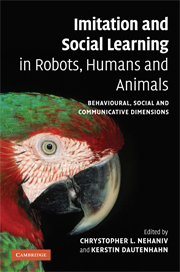 Imitation and Social Learning in Robots, Humans and Animals
Imitation and Social Learning in Robots, Humans and Animals Book contents
- Frontmatter
- Contents
- List of plates
- List of figures
- List of tables
- List of contributors
- Introduction: the constructive interdisciplinary viewpoint for understanding mechanisms and models of imitation and social learning
- Part I Correspondence problems and mechanisms
- Part II Mirroring and ‘mind-reading’
- Part III What to imitate?
- Part IV Development and embodiment
- Part V Synchrony and turn-taking as communicative mechanisms
- Part VI Why imitate? – Motivations
- Part VII Social feedback
- Part VIII The ecological context
- Index
- Plate section
Part VIII - The ecological context
Published online by Cambridge University Press: 10 December 2009
- Frontmatter
- Contents
- List of plates
- List of figures
- List of tables
- List of contributors
- Introduction: the constructive interdisciplinary viewpoint for understanding mechanisms and models of imitation and social learning
- Part I Correspondence problems and mechanisms
- Part II Mirroring and ‘mind-reading’
- Part III What to imitate?
- Part IV Development and embodiment
- Part V Synchrony and turn-taking as communicative mechanisms
- Part VI Why imitate? – Motivations
- Part VII Social feedback
- Part VIII The ecological context
- Index
- Plate section
Summary
The evolutionary history and ecological context of matching behaviour of various types plays an important role in shaping its character. In this section, two chapters show radically contrasting types of matching in the animal kingdom.
In the first by Ludwig Huber, the capacity of a highly socially intelligent species, the kea (Nestor notabilis) for emulation learning of object affordances is demonstrated by a series of ingenious experiments on the behaviour of this playful and curious bird that has not only survived, but thrived despite the invasion of its homeland, New Zealand, by humans and other troublesome mammals. When human-reared, ‘enculturated’ keas may exhibit even more of a propensity toward social learning by observing others (see the discussions of Tomasello and Call (1997) on the effects of enculturation on primate cognition). Combining their social learning capacity together with individual learning in a successful reconciliation of social and technical cognition, keas have benefited from and continue to employ social learning and curiosity to drive their success in their particular changing ecological context.
This kind of socially intelligent learning is in sharp contrast to the type of matching surveyed by Mark D. Norman and Tom Tregenza in the final chapter of this book. Mimicry here is a form of deceptive resemblance (see Cott, 1940; Wickler, 1968; Hanlon and Messenger, 1998), which in invertebrates is a type of matching generally unlikely to involve much intelligence or learning within individuals, but whose genesis generally operates on evolutionary timescales in particular ecological contexts rather than within the lifetime of single individuals.
- Type
- Chapter
- Information
- Imitation and Social Learning in Robots, Humans and AnimalsBehavioural, Social and Communicative Dimensions, pp. 425 - 426Publisher: Cambridge University PressPrint publication year: 2007
